Impaired Mitochondrial Energetics Characterize Poor Early Recovery of Muscle Mass Following Hind Limb Unloading in Old Mice
- PMID: 29562317
- PMCID: PMC6132115
- DOI: 10.1093/gerona/gly051
Impaired Mitochondrial Energetics Characterize Poor Early Recovery of Muscle Mass Following Hind Limb Unloading in Old Mice
Abstract
The progression of age-related sarcopenia can be accelerated by impaired recovery of muscle mass following periods of disuse due to illness or immobilization. However, the mechanisms underlying poor recovery of aged muscle following disuse remain to be delineated. Recent evidence suggests that mitochondrial energetics play an important role in regulation of muscle mass. Here, we report that 22- to 24-month-old mice with low muscle mass and low glucose clearance rate also display poor early recovery of muscle mass following 10 days of hind limb unloading. We used unbiased and targeted approaches to identify changes in energy metabolism gene expression, metabolite pools and mitochondrial phenotype, and show for the first time that persistent mitochondrial dysfunction, dysregulated fatty acid β-oxidation, and elevated H2O2 emission occur concomitantly with poor early recovery of muscle mass following a period of disuse in old mice. Importantly, this is linked to more severe whole-body insulin resistance, as determined by insulin tolerance test. The findings suggest that muscle fuel metabolism and mitochondrial energetics could be a focus for mining therapeutic targets to improve recovery of muscle mass following periods of disuse in older animals.
Figures
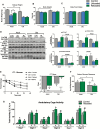
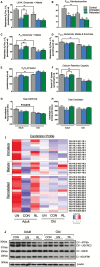
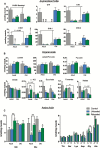
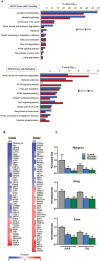
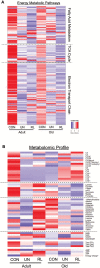
Similar articles
-
Loss of mitochondrial energetics is associated with poor recovery of muscle function but not mass following disuse atrophy.Am J Physiol Endocrinol Metab. 2019 Nov 1;317(5):E899-E910. doi: 10.1152/ajpendo.00161.2019. Epub 2019 Sep 3. Am J Physiol Endocrinol Metab. 2019. PMID: 31479303 Free PMC article.
-
Age-related deficits in skeletal muscle recovery following disuse are associated with neuromuscular junction instability and ER stress, not impaired protein synthesis.Aging (Albany NY). 2016 Jan;8(1):127-46. doi: 10.18632/aging.100879. Aging (Albany NY). 2016. PMID: 26826670 Free PMC article.
-
Skeletal muscle atrophy during short-term disuse: implications for age-related sarcopenia.Ageing Res Rev. 2013 Sep;12(4):898-906. doi: 10.1016/j.arr.2013.07.003. Epub 2013 Aug 12. Ageing Res Rev. 2013. PMID: 23948422 Review.
-
Sustained NFκB inhibition improves insulin sensitivity but is detrimental to muscle health.Aging Cell. 2017 Aug;16(4):847-858. doi: 10.1111/acel.12613. Epub 2017 May 29. Aging Cell. 2017. PMID: 28556540 Free PMC article.
-
Mitochondria, muscle health, and exercise with advancing age.Physiology (Bethesda). 2015 May;30(3):208-23. doi: 10.1152/physiol.00039.2014. Physiology (Bethesda). 2015. PMID: 25933821 Review.
Cited by
-
Exercise and nutrition benefit skeletal muscle: From influence factor and intervention strategy to molecular mechanism.Sports Med Health Sci. 2024 Feb 27;6(4):302-314. doi: 10.1016/j.smhs.2024.02.004. eCollection 2024 Dec. Sports Med Health Sci. 2024. PMID: 39309454 Free PMC article. Review.
-
Macrophage Regulation of Muscle Regrowth From Disuse in Aging.Exerc Sport Sci Rev. 2019 Oct;47(4):246-250. doi: 10.1249/JES.0000000000000201. Exerc Sport Sci Rev. 2019. PMID: 31525165 Free PMC article. Review.
-
RNA sequencing (RNA-seq) analysis of gene expression provides new insights into hindlimb unloading-induced skeletal muscle atrophy.Ann Transl Med. 2020 Dec;8(23):1595. doi: 10.21037/atm-20-7400. Ann Transl Med. 2020. PMID: 33437794 Free PMC article.
-
Neutralizing mitochondrial ROS does not rescue muscle atrophy induced by hindlimb unloading in female mice.J Appl Physiol (1985). 2020 Jul 1;129(1):124-132. doi: 10.1152/japplphysiol.00456.2019. Epub 2020 Jun 18. J Appl Physiol (1985). 2020. PMID: 32552434 Free PMC article.
-
Advances in Understanding of the Role of Lipid Metabolism in Aging.Cells. 2021 Apr 13;10(4):880. doi: 10.3390/cells10040880. Cells. 2021. PMID: 33924316 Free PMC article. Review.
References
-
- Zarzhevsky N, Carmeli E, Fuchs D, Coleman R, Stein H, Reznick AZ. Recovery of muscles of old rats after hindlimb immobilisation by external fixation is impaired compared with those of young rats. Exp Gerontol. 2001;36: 125–140. - PubMed
-
- Dardevet D, Sornet C, Taillandier D, Savary I, Attaix D, Grizard J. Sensitivity and protein turnover response to glucocorticoids are different in skeletal muscle from adult and old rats. Lack of regulation of the ubiquitin-proteasome proteolytic pathway in aging. J Clin Invest. 1995;96: 2113–2119. doi:10.1172/JCI118264 - PMC - PubMed
-
- Hao Y, Jackson JR, Wang Y, Edens N, Pereira SL, Alway SE. β-Hydroxy-β-methylbutyrate reduces myonuclear apoptosis during recovery from hind limb suspension-induced muscle fiber atrophy in aged rats. Am J Physiol Regul Integr Comp Physiol. 2011;301: R701–R715. doi:10.1152/ajpregu.00840.2010 - PMC - PubMed
Publication types
MeSH terms
Substances
Grants and funding
LinkOut - more resources
Full Text Sources
Other Literature Sources
Medical
Molecular Biology Databases

